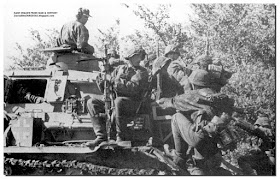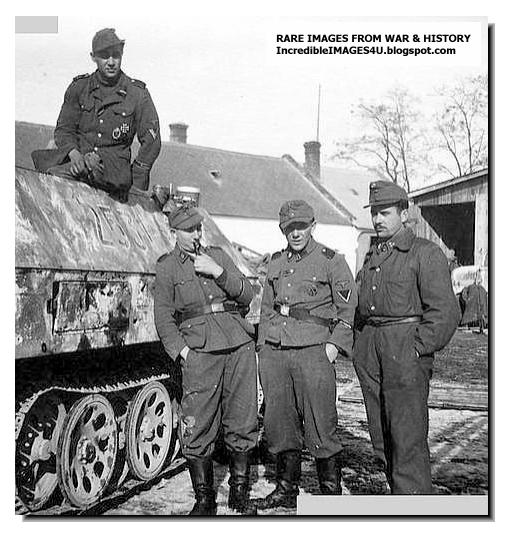Men of the SS 'Viking' Division enjoy a smoke after some heavy fighting. Eastern Front
Ace Panzer commander of the SS, Michael Wittmann
WHO WAS MICHAEL WITTMANN?
Michael Wittmann (April 22, 1914 – August 8, 1944) was a German Waffen-SS tank commander during the Second World War. Wittmann would rise to the rank of SS-Hauptsturmführer (captain) and was a Knight's Cross of the Iron Cross holder.
He was credited with the destruction of 138 tanks and 132 anti-tank guns, along with an unknown number of other armoured vehicles, making him one of Germany's top scoring panzer aces, together with Johannes Bölter, Ernst Barkmann, Otto Carius and Kurt Knispel who was the top scoring ace of the war with 168 tank kills.
Wittmann is most famous for his ambush of elements of the British 7th Armoured Division, during the Battle of Villers-Bocage on 13 June 1944. While in command of a single Panzerkampfwagen VI Tiger he destroyed up to 14 tanks and 15 personnel carriers along with 2 anti-tank guns within the space of 15 minutes.
Eastern Front. Men of the SS 'Totenkopf' Division
Reichsfuehrer Heinrich Himmler addresses the Volkssturm. October 1944
Battle hardened Waffen SS men during the Battle Of Kursk
Eastern Front. 1941. Men from the SS 'Viking' Division
Men of the 'Das Reich' Division with a captured Soviet banner
Waffen SS 'Leibstandarte Adoph Hitler' Division in Belgium. June 1944
2nd SS Mountain "Nord" Division
Waffen SS men in 1941. Eastern Front
Theodor Eicke, commander of the 3rd SS Panzer 'Totenkopf' Division
Theodor Eicke again. 3rd SS Panzer 'Totenkopf' Division
Men of 'Totenkopf' prepare for an assault
SS men prepare to attack
SS men during Operation Citadel. 1943
Posing for a group photograph
SS man with a MG 42 machine gun during Operation Citadel (Battle of Kursk)
Mine-sweeper of the 5th-SS Panzer 'Viking' Division
'Viking' Division in Hungary. 1944
SS guards at Heydrich's office in Prague


Related
WAFFEN SS: Training Made Them The Best: Personal Narrative Of A Recruit
Suggested Reading

WAFFEN SS: Training Made Them The Best: Personal Narrative Of A Recruit
Suggested Reading

A nice introduction to the SS. The SS (Stosstrupp Adolf Hitler) was a number of things--Hitler's body guard, law enforcement duties, concentration camp controllers, and soldiers (the Waffen-SS). This volume examines the work of the SS from 1939-1945. Early on, there was competition between the SA and the SS (to be devoted to Hitler, whereas the SA had other ambitions). With the demise of the SA, the SS became that much more important.
The SS had two elements--the Waffen-SS, the military arm, and the Allgemeine-SS, a police and security force with tentacles throughout German society. The second chapter lays out the variety of responsibilities of the Allgemeine-SS nicely. In addition to describing the "tentacles," this discussion also considers recruitment and training, symbolism (the death's head--totenkopf), uniforms, flags, and so on.
Then, the Waffen-SS. Appearance, equipment, training, weapons, tactics, and famous commanders, such as Sepp Dietrich. Some of the more legendary divisions in the Waffen-SS: Leibstandarte Adolf Hitler, Das Reich, and Totenkopf. Other formations emerged, too, such as Wiking, a division made up of volunteers from Denmark, the Netherlands, Norway, etc. The racial exclusivity of the Waffen-SS began to be compromised as needs for soldiers became more pressing as the war continued.
The book discusses the fighting power of the Waffen-SS—and its slow disintegration as it was bled to death in the Soviet Union and in France after the Normandy invasion. There were a few last hurrahs, such as in the Battle of the Bulge, but this element was slowly ground down due to causalities and inferior replacements.
Overall, an accessible and readable portrayal of the SS. .
------------------------------------



























No comments:
Post a Comment